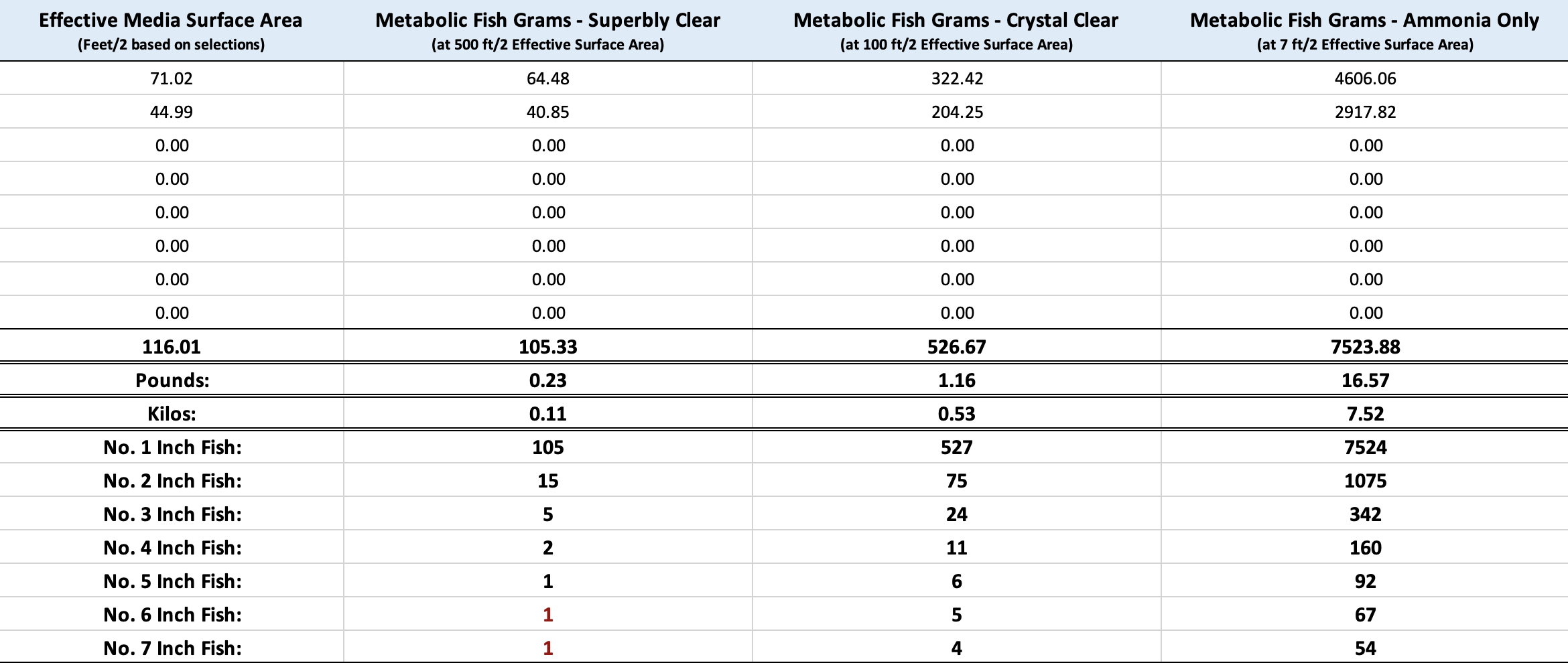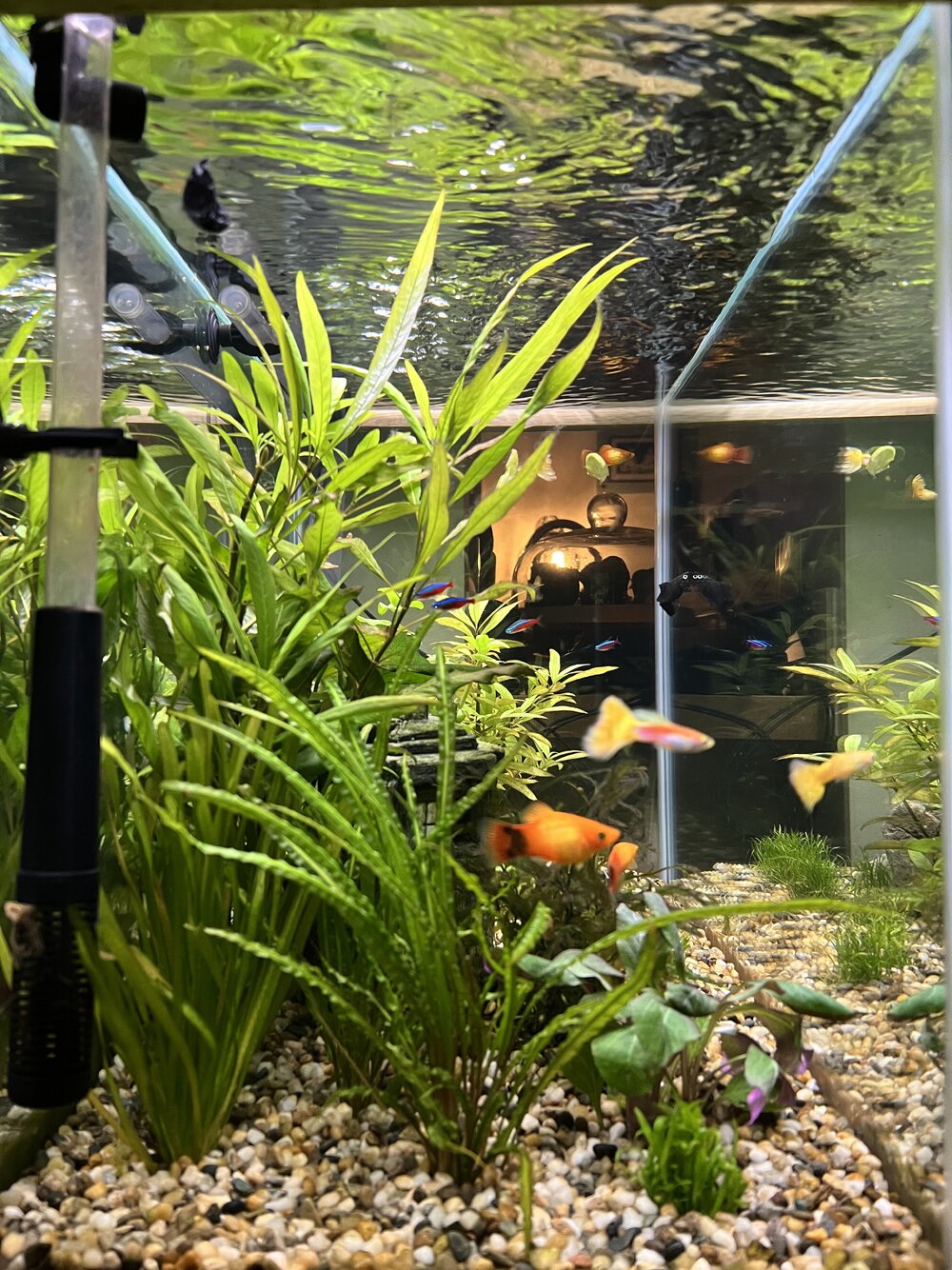-
You are viewing the forum as a Guest, please login (you can use your Facebook, Twitter, Google or Microsoft account to login) or register using this link: Log in or Sign Up
You are using an out of date browser. It may not display this or other websites correctly.
You should upgrade or use an alternative browser.
You should upgrade or use an alternative browser.
Filter Media for Fish Stocking Calculator
- Thread starter Bradders
- Start date
Yes, I agree; it's a bit all over the place at the moment! I should include both somehow. I'll add to the list. Thank you.Do you think there’s any merit in converting to metric?
Le duke
Member
I actually messed up here; I short changed the FX6 and FX4 for some unknown reason. My original values used an incorrect sponge dimension.You can see the figures below of the FX6 beast! 737 Cubic Inches (assuming all 20PPI foam) gives you staggering filtering capability! 😵
View attachment 215177
Took out a spare, new side filter sponge for an FX4/5/6 and measured it. It's 15 x 3.5 x 1.5". Or 38.1 x 8.9 x 3.8cm. 78.75 in^3/1290 cm^3 each, and there are 6 of those in an FX6. 472 cubic inches in total from just the side filter sponges.
Then, the center discs, of which there are 9 in my FX6 filter. 6.5 inches in diameter, 1" thick. pi * r^2 * thickness * number of sponges. 3.14159 * 3.25^2 * 1" * 9 = 298.6 cubic inches.
771 total cubic inches / 12.6 liters of 20 ppi. It comes with some ceramic media and charcoal-impregnated foam media, stock, in the center chambers but I replaced all of that stuff with 20ppi Poret.
OK, so the revised figure looks like the one below - it remains an absolute whopper. 527g / 1.16 lbs of fish with Crystal Clear water. (Bearing in mind this is JUST focused on media, nothing else).I actually messed up here; I short changed the FX6 and FX4 for some unknown reason. My original values used an incorrect sponge dimension.

But now let us say that you had the ceramic involved in the centre, leaving the outside foams in place. (This is VERY rough at the moment, exchanging foam with balls). You are dropping 181g / 0.4 lbs of fish.

To summarise the power of the FX6 with the RIGHT media (i.e. between foam and ceramics), it's like moving from 75 2-inch fish to 49 2-inch fish. i.e. a better media would give you 26 more 2-inch fish.
This is petty indicative, but it does show the capability of the FX6 and also the importance of media.
Attachments
I do follow these guidances quite a lot. i.e., good aeration and checking my bio-load to filter capacity for clear water.
My aquarium is absolutely tiny compared to @Le duke aquarium (and very unsophisticated as I am very new to plants!), but it has helped produce clear water., even before the addition of the plants.
The far-right neon is at the end of the tank, and the light is 11 feet / 3.24 meters away.

My aquarium is absolutely tiny compared to @Le duke aquarium (and very unsophisticated as I am very new to plants!), but it has helped produce clear water., even before the addition of the plants.
The far-right neon is at the end of the tank, and the light is 11 feet / 3.24 meters away.

Last edited:
Just an update, as I really can't stop messing around with Excel!
- Added some basic calculations on aeration requirements.
- Added a fish weight calculator, which also compares to filter capacity.
- Added some basic calculations of fish feeding level based on fish weight.
Hi all,
Sanni L. Aalto, Carlos O. Letelier-Gordo, Lars-Flemming Pedersen, Per Bovbjerg Pedersen, (2022) "Effect of biocarrier material on nitrification performance during start-up in freshwater RAS", Aquacultural Engineering, 99, <"https://www.sciencedirect.com/science/article/pii/S0144860922000681">
cheers Darrel
This is an interesting paper. It looks at <"K1 type media"> nitrification rates and efficiency in <"moving bed bioreactor filters"> (MBBR) used in aquaculture.I do follow these guidances quite a lot. i.e., good aeration and checking my bio-load to filter capacity for clear water.
My aquarium is absolutely tiny compared to @Le duke aquarium (and very unsophisticated as I am very new to plants!), but it has helped produce clear water., even before the addition of the plants.
Sanni L. Aalto, Carlos O. Letelier-Gordo, Lars-Flemming Pedersen, Per Bovbjerg Pedersen, (2022) "Effect of biocarrier material on nitrification performance during start-up in freshwater RAS", Aquacultural Engineering, 99, <"https://www.sciencedirect.com/science/article/pii/S0144860922000681">
So a low carrier to water ratio, this allows the chips to move around and makes sure that they all remain fully oxygenated...... In the beginning of the experiment, each biofilter was filled with 13L of biocarriers, leading to the filling rate of 14%, which was low enough to allow the carriers to be fully mixed and to ensure sufficient substrate loading of the biofilters.....
Colour doesn't count (and I'm not sure why it would)." ..... In this study, we compared otherwise identical biocarriers made of polyethylene (PE) against ones made of polypropylene (PP) and PP biocarriers with three different levels of pigment (carbon black) addition (without added pigment, semi-pigmented, fully-pigmented). The four types of biocarriers were tested in 12 parallel moving bed bioreactors under identical conditions receiving water from a semi-commercial freshwater RAS with rainbow trout. Measurements of total ammonium nitrogen (TAN) and nitrite-nitrogen (NO2--N) removal rates and nitrification kinetics were carried out by spiking events with NH4Cl or NaNO2 two, four, and six weeks after start-up. The results showed all biofilters removed TAN only after two weeks of operation........"
So similar findings to <"Correspondence with Dr Ryan Newton - School of Freshwater Sciences, University of Wisconsin—Milwaukee">. This was what Dr Newton said:........ All biofilters exhibited nitrification activity already after two weeks of operation, the average TAN removal rate being 0.31gN/m2/d, while typically functional biofilters are achieved after 4–6 weeks of operation (e.g. Kuhn et al., 2010; Pulkkinen et al., 2018). This was probably due to the inoculation biofilter containing mature biocarriers, which may have facilitated a faster biofilter start-up by supplying microbes that colonized the virgin biocarriers in the twelve experimental biofilters. This result corroborates the previous findings on biofilter seeding to shorten startup period.......
....... In some lab tests we found that adding previous material from a running biofilter could reduce ammonia oxidation start-up time from 2-3 weeks to 2-3 days. We also tested a commercial product of nitrifiers & it did decrease the time to ammonia oxidation start-up. It was slower than our biofilter material transfer, but much quicker than doing nothing. However, the microbes present in the system from the commercial product disappeared over a few weeks and were replaced by those more common to our system. So, it seems some products could help “jump-start” the process, but it will be a lot less predictable and ultimately may not determine what microbe succeed in the long run....
cheers Darrel
Last edited:
Apologies, links updated:The excel link seems not work, can you kindly share this file again? Thanks!
iCloud Drive - Apple iCloud
Store, organize and collaborate on files and folders with iCloud Drive. Easily upload, delete or recover files. Changes will sync across your devices with iCloud.
Aqua sobriquet
Member
Many years ago I had a heavily stocked 50 gallon community tank running on an Eheim Classic 250.
I used filter floss in those days so that required regular replacement. Apart from that no problems. I tried a variety of media over the years including ceramic rings and Dupla Bio Balls. Fish deaths were extremely rare and I had a pair of breeding Cichlids that produced lots of offspring. By today’s standards the filter was woefully inadequate. Using London tap water though I found it impossible to grow plants. They were gradually replaced as they died off. Some took many months, others didn’t last long. I’m absolutely sure the bio capacity of the filters on my two Nano’s - 60L and 37L far exceed what I had then. As you know by now ( sorry 🫤 ) I’m a big fan of Siporax and wouldn’t hesitate to use it on a heavily stocked tank (with a pre filter) on the inlet. I probably wouldn’t have looked at it but I bought a Sera canister filter and it came supplied with the Siporax.
Over the years, I’ve been trying to think of a use for the unused packets of ceramic rings that came with various filters. I don’t like throwing anything away! 😆
I used filter floss in those days so that required regular replacement. Apart from that no problems. I tried a variety of media over the years including ceramic rings and Dupla Bio Balls. Fish deaths were extremely rare and I had a pair of breeding Cichlids that produced lots of offspring. By today’s standards the filter was woefully inadequate. Using London tap water though I found it impossible to grow plants. They were gradually replaced as they died off. Some took many months, others didn’t last long. I’m absolutely sure the bio capacity of the filters on my two Nano’s - 60L and 37L far exceed what I had then. As you know by now ( sorry 🫤 ) I’m a big fan of Siporax and wouldn’t hesitate to use it on a heavily stocked tank (with a pre filter) on the inlet. I probably wouldn’t have looked at it but I bought a Sera canister filter and it came supplied with the Siporax.
Over the years, I’ve been trying to think of a use for the unused packets of ceramic rings that came with various filters. I don’t like throwing anything away! 😆





